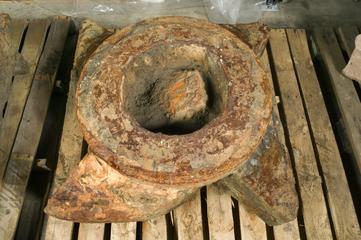
Model of disc engine.
- Made:
- c.1830 in Derbyshire

Model of Dakeyne disc engine on wooden base.
The disc engine was patented by Messrs. E. and J. Dakeyne in 1830, and subsequently improved by Messrs. W. Taylor and H. Davies, besides others. In 1841 Messrs. Ransomes and Sims showed at Liverpool a Davies rotary engine of 5 h.p., the first portable engine on wheels. It drove a thrashing machine and was rendered self-propelling by pitch chains from the crankshaft to the travelling axle. A similar engine was applied with some success by Messrs. G. and J. Rennie to drive a screw propeller (see Marine Engineering Collection); more recently the arrangement has been extensively used as a water meter. The chamber, which acts as a cylinder, is enclosed laterally by a spherical zone and endwise by a pair of cones whose apexes come together. The piston is a circular disc fitting the interior of the zone round its edge, and having at its centre a ball which forms the joint on which it gyrates. From the ball, and perpendicular to the disc, projects a rod whose further end is socketed in a crank arm attached to the shaft to be driven. There is a fixed radial partition in the cylinder, and a corresponding slot in the disc permits of the requisite motion. The disc and partition divide the chamber into four spaces, two of which are expanding while the other two are contracting; steam is admitted into the former and discharged from the latter by ports formed through the spherical wall of the chamber, one on each side of the partition, and the disc itself, by its motion over them, performs the function of a valve. The engine may be reversed by interchanging the inlet and exhaust passages.
Details
- Category:
- Motive Power
- Object Number:
- 1893-172
- Materials:
- mahogany (wood), brass (copper, zinc alloy) and steel (metal)
- type:
- model
- credit:
- Mr R.B. Prosser




